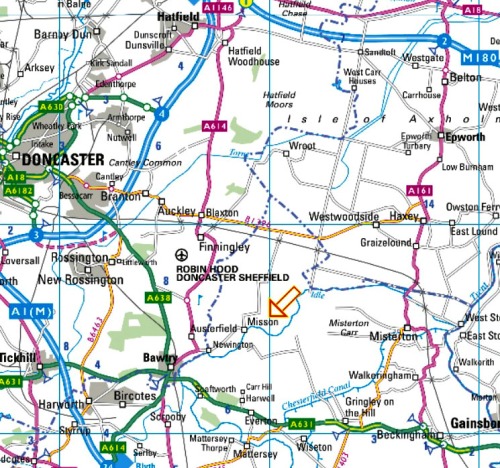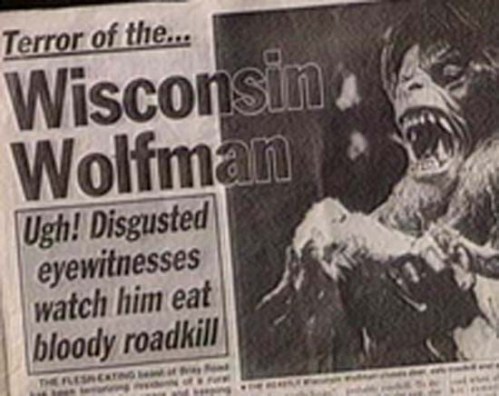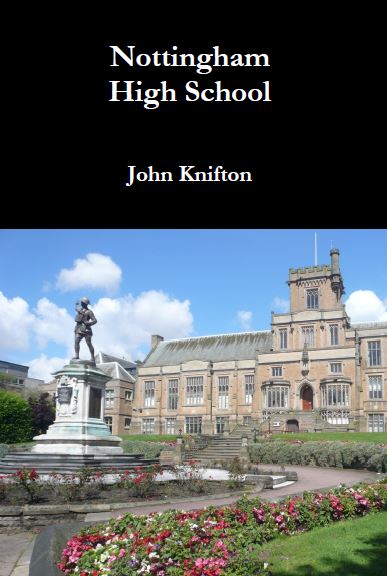I have written a good deal, some would say too much, about the monsters which terrorized France between 1500 and the end of the nineteenth century. The most conservative zoologists say that the so-called monsters were just wolves behaving badly. Other more daring individuals say they were cave hyenas or dire wolves or waheelas or whatever:
This slideshow requires JavaScript.
I personally think that they were some kind of Superwolf which was like generally pretty much like an ordinary wolf in appearance, but with enough differences in behaviour to stand out from the rest. Just enough for the French peasant of 1764-1767 to think to himself, “C’était comme un loup, mais ce n’était pas un loup.”
What I have never imagined as the solution to this blood spattered conundrum is the werewolf. In French, it is the Loup-garou:

The Americans in those areas of the USA which have a French heritage call it the Rougarou, rather as if somebody in 1700 had slightly misheard the word. Given that the Rougarou allegedly lives in the bayou and perhaps makes a “Wooo-hooo” call, I have always been somewhat surprised that no aspiring songwriter has ever taken up this subject.

Nobody, though, would expect there to be any claims of werewolves, Loup-garou or Rougaroux in England, but, of course, there have been. I visited a forum recently, and they mentioned not one, but several.

In two cases, back in the day, they were unknown creatures that attacked livestock and left a trail of blood and gore. That could have been anything, of course, perhaps even the first Alien Big Cats in the country but much more likely to have been just feral dogs, which regularly kill both people and livestock in far larger numbers than either wolves or werewolves:

There was mention of a genuine werewolf near Ripon, Yorkshire, in the 1920s and then another in Edale, Lancashire, in 1925. It was described by the forum contributor, Jerry_B as “some large animal…tearing sheep to bits”. Sounds like it’s back to those feral dogs to me.
A bloodsucking equivalent of these two werewolves, allegedly, was the monster “on the prowl in 1905, at Badminton (Gloucester)”.
All of these seem extremely far-fetched in my humble opinion, but there is one interesting English werewolf tale which features very widely on the Internet. For me though, it is a superb example of putting a couple of interesting facts together, and then using them to come to a fairly ridiculous conclusion. After that, everybody is more than happy to view this iffy conclusion as completely sensible and to consider it henceforth as hard fact. No need to bother about questioning the reasoning process. If you still don’t understand what I’m getting at, then treat yourself to the finest example I know of, namely any episode whatsoever in the “Ancient Aliens” TV series.
.
First of all, though, for the sake of argument, I am willing to accept the supposition, for the moment, that wolves in England, centuries ago, were capable of behaviour that, nowadays, would be dismissed as being highly unlikely. That behaviour, of course, would be to treat human beings as a prey item and to attack them as a matter of ordinary routine:

Whatever you may think about that as a supposition, the author, John Harries, in his book “A Ghost Hunter’s Road Book”, states that things were so bad in Saxon times that, presumably at the behest of King Aethelstan:
“ about the year 940 AD a hostel was built in the village of Flixton to shelter wayfarers in wintertime from attacks by wolves. At that period packs of the animals were not uncommon in the north of the country, and they were regarded with particular loathing because in times of severe weather they scavenged in graveyards.”
That statement is by no means outrageous, although it would be nice to know where the story originally came from. After all, there cannot be too many sources available to be cited when it comes to events more than a thousand years ago in 940 AD.
What tips it over the edge, though, is the next piece of rather iffy logic:
“Their cunning in discovering unprotected cattle, their boldness in attacking travellers, and their habit of suddenly descending in large numbers on an area where they had previously been unknown, all helped to give rise to the belief that the animals were not ordinary wolves but human beings who adopted a travesty of wolf shape by night.”
Wolves capable of finding “unprotected cattle”? How unusual! How unprecedented! I’m sure that has never happened in the northern states of the USA.
“Descending in large numbers” to a source of easy food? How extraordinary for a pack predator to be any good at doing that!

The wolf is one of the most widespread and successful predators on the planet. So why do we need to explain his achievements as the work of werewolves? And not even ordinary werewolves at that…
“Their nocturnal exploits were supposed to be organised by a wizard whose innocent appearance enabled him to gather information about cattle, sheep and human wayfarers in taverns and market places.”
Look out! There’s a wizard about!! Careless talk costs lives!!
Flixton, by the way, is in Yorkshire, in the north of England, near Scarborough. Look for the orange arrow:

Here is a more detailed map:

Further details about the Flixton Werewolf were that he has glowing red eyes and a particularly bad body odour. (Don’t say it!) Reports supposedly began all over again in 1150, although by now he had grown a very long tail. In 1800 a stagecoach making its way to York was supposedly attacked by an apparent werewolf. In 1970, the Flixton Werewolf made an unsuccessful attempt at attacking a long distance lorry. Easy prey, of course:

All these additional details, and a succession of precise dates, all help to give the story of a werewolf in Yorkshire veracity and credence, of course.
I was able to find mention on the Internet of just a two other werewolves in England, both of them in Devon (in the Valley of the Rocks in Lynton and the Valley of the Doones on Exmoor). On the latter occasion, a Victorian lady walking home in the dark saw a grey man with a wolf’s head, apparently stalking a large rabbit. The grey man disappeared when he was disturbed by a stag emerging suddenly from some nearby woodland.
Funnily enough, this apparently bizarre tale of the grey man with a wolf’s head sounds a lot more probable to me. If you have read my articles about Shuck and then the Wolfmen in the USA, you may recall that the almost cute behaviour of this grey man with a wolf’s head is much more typical of these cryptocanids:
 Much more interesting than the Flixton Werewolf though, was the article I found by Nick Redfern about Wolfmen in the Cannock Chase German Cemetery. Nick’s approach is much more studied and cautious, and it is remarkable how close his “2+2” comes to equalling the “4” of Linda S.Godfrey in her description of such entities as the Beast of Bray Road and the Michigan Dogman. Reports mentioned by Nick include:
Much more interesting than the Flixton Werewolf though, was the article I found by Nick Redfern about Wolfmen in the Cannock Chase German Cemetery. Nick’s approach is much more studied and cautious, and it is remarkable how close his “2+2” comes to equalling the “4” of Linda S.Godfrey in her description of such entities as the Beast of Bray Road and the Michigan Dogman. Reports mentioned by Nick include:
“Nick Duffy, of the West Midlands Ghost Club, reported that “The first person to contact us was a postman, who told us he had seen what he thought was a werewolf. He saw what he believed was a large dog, but when he got closer, the creature got on his hind legs and ran away.”
The next report was:
“A local scout-leader reported that: “It just looked like a huge dog. But when I slammed the door of my car it reared up on its back legs and ran into the trees. It must have been about six to seven feet tall.”
Both of these pieces of behaviour come much, much closer to the Dogmen and Werewolves of the USA. If you read Linda S.Godfrey, you will see that the majority of these monsters prefer not to attack but to run away:

Let’s finish with two things. Firstly a question. Why do you always have to shoot a werewolf with a silver bullet to kill it?

It’s because back in the days of muskets and similar hit-and-miss weapons, accuracy was way below today’s standards, as was killing power. One, albeit expensive, way to improve both was to discard the third rate bullets of the day, and make your own, rock hard, bullets from…you’ve guessed it! Silver.
And secondly I was unaware that when they were filming that classic tale “An American Werewolf In London”, the opening scenes on the Yorkshire moors were all filmed in Wales because “Yorkshire didn’t look Yorkshire enough”:


































